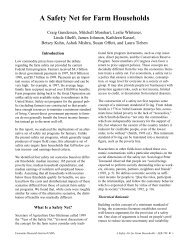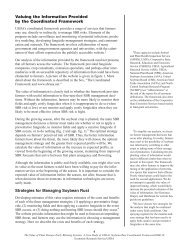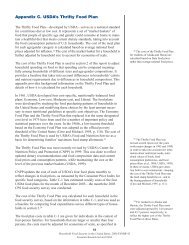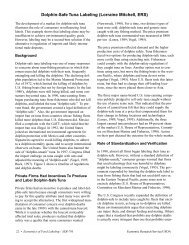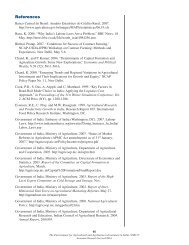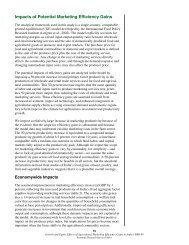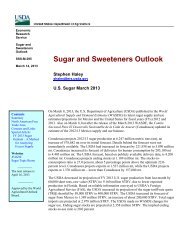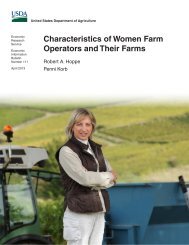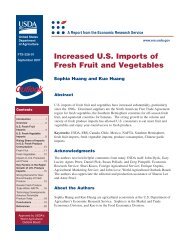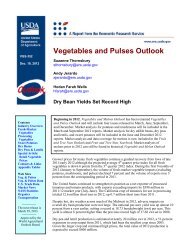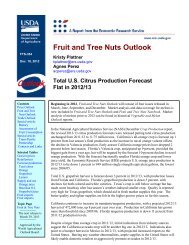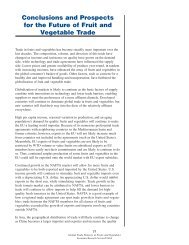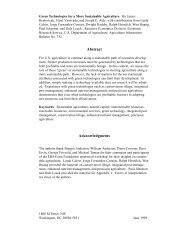Expansion of Modern Grocery Retailing and Trade in - Economic ...
Expansion of Modern Grocery Retailing and Trade in - Economic ...
Expansion of Modern Grocery Retailing and Trade in - Economic ...
You also want an ePaper? Increase the reach of your titles
YUMPU automatically turns print PDFs into web optimized ePapers that Google loves.
Only the share <strong>of</strong> the work<strong>in</strong>g-age population is statistically significant.<br />
Furthermore, this variable has a large <strong>and</strong> significant impact on the growth<br />
<strong>of</strong> penetration <strong>in</strong> all specifications. The results <strong>in</strong> column 1 imply that an<br />
<strong>in</strong>crease <strong>in</strong> ShareWork<strong>in</strong>g by one st<strong>and</strong>ard deviation (.068) is associated with<br />
an <strong>in</strong>crease <strong>in</strong> penetration by 4.0 percent. On the other h<strong>and</strong>, none <strong>of</strong> the<br />
other variables—either supply or dem<strong>and</strong> proxies—are consistently correlated<br />
with growth <strong>in</strong> modern penetration across specifications.<br />
Exam<strong>in</strong>ation <strong>of</strong> the extent to which growth <strong>in</strong> modern retail penetration is<br />
associated with different subsets <strong>of</strong> the work<strong>in</strong>g-age population may provide<br />
additional <strong>in</strong>sight. For example, growth can stem primarily from younger<br />
workers adopt<strong>in</strong>g new formats <strong>and</strong> products, or possibly from all <strong>of</strong> the<br />
work<strong>in</strong>g population utiliz<strong>in</strong>g the convenience <strong>of</strong> readymade foods <strong>and</strong> onestop<br />
shopp<strong>in</strong>g. To <strong>in</strong>vestigate the role <strong>of</strong> various population segments, the<br />
share <strong>of</strong> work<strong>in</strong>g-age population variable is disaggregated <strong>in</strong>to the shares <strong>of</strong><br />
the work<strong>in</strong>g-age population under age 30, between 30 <strong>and</strong> 49, <strong>and</strong> from 50 to<br />
64. These results are shown <strong>in</strong> column 3 <strong>of</strong> table 3 <strong>and</strong> <strong>in</strong>dicate that the share<br />
<strong>of</strong> the work<strong>in</strong>g-age population ages 30-49 has the most significant impact<br />
on modern retail growth; the coefficients estimated for the other age groups<br />
are both smaller <strong>in</strong> magnitude <strong>and</strong> not statistically significant. Given that<br />
the correlation is not driven by younger households only, it seems likely that<br />
faster growth <strong>in</strong> modern retail<strong>in</strong>g has been primarily associated with populations<br />
dem<strong>and</strong><strong>in</strong>g convenience rather than changes <strong>in</strong> food preferences associated<br />
with younger consumers.<br />
By contrast, none <strong>of</strong> the proxies for efficiency growth is associated with<br />
growth <strong>in</strong> modern retail penetration. None <strong>of</strong> the coefficients on the efficiency<br />
proxies are statistically significant <strong>in</strong> any <strong>of</strong> the specifications (table<br />
3). Furthermore, the estimated st<strong>and</strong>ard errors <strong>of</strong> the coefficients are small<br />
enough to preclude a relationship as economically mean<strong>in</strong>gful as the share <strong>of</strong><br />
work<strong>in</strong>g-age population <strong>in</strong> any <strong>of</strong> the specifications. For example, <strong>in</strong> column<br />
(2), the effect <strong>of</strong> <strong>in</strong>creas<strong>in</strong>g the BusRank coefficient by one st<strong>and</strong>ard deviation<br />
us<strong>in</strong>g the bounds <strong>of</strong> the 95-percent confidence <strong>in</strong>terval is still smaller<br />
than the effect <strong>of</strong> <strong>in</strong>creas<strong>in</strong>g the share <strong>of</strong> work<strong>in</strong>g-age population coefficient<br />
by one st<strong>and</strong>ard deviation. 11<br />
A previous study (Traill, 2006), us<strong>in</strong>g a smaller sample consist<strong>in</strong>g <strong>of</strong> both<br />
developed <strong>and</strong> develop<strong>in</strong>g countries, found the level <strong>of</strong> penetration <strong>of</strong> modern<br />
formats to be positively correlated with <strong>in</strong>come per capita. Thus, column 4 <strong>of</strong><br />
table 3 estimates a specification that regresses the level <strong>of</strong> penetration <strong>in</strong> 2004<br />
on the proxies for dem<strong>and</strong> growth for nonprice characteristics <strong>and</strong> efficiency<br />
growth <strong>in</strong> the supply cha<strong>in</strong> associated with the expansion <strong>of</strong> modern formats.<br />
These results also suggest that penetration <strong>of</strong> modern grocery formats is<br />
higher <strong>in</strong> countries where GDP per capita is higher. Additionally, penetration<br />
is smaller where GDP growth is faster. However, countries with the highest<br />
growth rates also tend to be much poorer on average, suggest<strong>in</strong>g a relationship<br />
between the rate <strong>of</strong> penetration <strong>and</strong> base <strong>in</strong>come level.<br />
Despite these correlations between the level <strong>of</strong> penetration <strong>and</strong> the level <strong>and</strong><br />
growth <strong>of</strong> <strong>in</strong>come, columns 1-3 demonstrate that these relationships do not<br />
survive the first difference, <strong>in</strong> which many time-<strong>in</strong>variant factors drop out<br />
<strong>of</strong> the estimation. 12 Thus, we cannot uncover whether supermarket penetration<br />
is higher <strong>in</strong> richer develop<strong>in</strong>g <strong>and</strong> transition countries simply because <strong>of</strong><br />
14<br />
The <strong>Expansion</strong> <strong>of</strong> <strong>Modern</strong> <strong>Grocery</strong> <strong>Retail<strong>in</strong>g</strong> <strong>and</strong> <strong>Trade</strong> <strong>in</strong> Develop<strong>in</strong>g Countries / ERR-122<br />
<strong>Economic</strong> Research Service/USDA<br />
11 Given that modern grocery retail<strong>in</strong>g<br />
began at different times <strong>in</strong> different<br />
regions, we also analyze whether<br />
these proxies for efficiency ga<strong>in</strong>s were<br />
correlated with the growth <strong>in</strong> penetration<br />
<strong>in</strong> different waves. Specifically,<br />
we estimate the basel<strong>in</strong>e empirical<br />
specification but <strong>in</strong>teract the efficiency<br />
proxies with dummy variables<br />
<strong>in</strong>dicat<strong>in</strong>g the order <strong>in</strong> which countries<br />
started to develop modern grocery<br />
retail<strong>in</strong>g, as described by Reardon et al.<br />
(2003). None <strong>of</strong> these differences are<br />
statistically different. We also allow for<br />
the effect <strong>of</strong> proxies to vary by <strong>in</strong>come<br />
level. However, <strong>in</strong> those specifications,<br />
we still f<strong>in</strong>d that only the share<br />
<strong>of</strong> work<strong>in</strong>g-age population is correlated<br />
with penetration <strong>of</strong> modern grocery<br />
retail<strong>in</strong>g.<br />
12 Although many <strong>of</strong> the variables <strong>in</strong><br />
the estimation are static, <strong>in</strong>clud<strong>in</strong>g the<br />
share <strong>of</strong> the work<strong>in</strong>g-age population,<br />
these factors are be<strong>in</strong>g <strong>in</strong>terpreted as<br />
proxies for either growth <strong>in</strong> dem<strong>and</strong><br />
for nonprice characteristics <strong>of</strong> food or<br />
growth <strong>in</strong> supply cha<strong>in</strong> efficiency.



